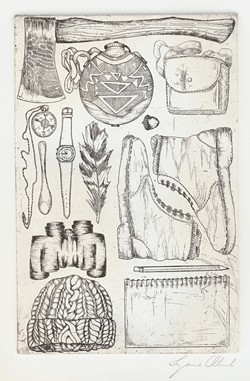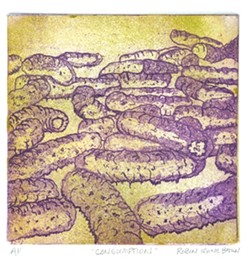In the documentary Art Is … the Permanent Revolution (screening, incidentally, at SLOMA on June 16—look directly to your left for more information), printmaker Sigmund Abeles gives a charming account from the history of etchings in Europe: An ambitious engraver of armor in, say, Germany, might want to show off his skills to another maker of armor, or even a customer in, say, Italy. But suppose he doesn’t want to send an entire suit of armor halfway across the known world? An etching served as a way to create a small copy of the engraved design that could travel easily.
- CUT AND PRINT: The Cuesta College Student Printmakers exhibit runs through June 29, upstairs in SLOMA’s McMeen Gallery, 1010 Broad St. in SLO. Museum hours are 11 a.m. to 5 p.m. daily except Tuesdays. For more information, visit sloma.org or call 543-8562
The long-established roots of the medium are the driving force behind this year’s Cuesta College Student Printmakers exhibit at SLOMA, sponsored by the Central Coast Printmakers. Inspired by a used bookstore find, John J. Barry’s instructional 1929 volume How to Make Etchings, Cuesta printmaking instructor Leslie Sutcliffe chose to focus this year’s show on drypoint, hard and soft ground etching, and aquatint—the three basic techniques on which Barry also focuses. “I was taken by how little had changed from the way these processes were presented in this little book and the way I teach them in my classes. I was delighted by the feeling that I was passing on a tradition that was already hundreds of years old in 1929,” Sutcliffe says in the exhibit’s opening statement.
The found-object nature of this theme corresponds well with the visual impact of the prints themselves. Together they look like illustrations torn from the same curious, motley book: A First Encyclopedia of Tlön from Borges, perhaps. It would be overkill to know the story; this collection of images is dreamlike rather than didactic. They have neither obvious central theme nor subject—and they shouldn’t. Instead, they share a form, they bind together in contiguous circles like oil on the surface of water.

- IMAGE COURTESY OF LAUREN MILBOURNE
- CAMP ’N’ PACK: Suzanne Alward’s motto? Be prepared.
On the landing at the entrance to the McMeen gallery, a handful of prints introduce the exhibit even before it begins. Vera von Rauner’s Ol’ Lady Coon Eyes (presumably an unintentionally provocative title that, unless it means to make a statement beyond sounding old-timey, as in “coonskin cap,” would benefit from alteration), features a pair of shape-shifting reading glasses more animalistic than inanimate. The finishing touch of a little tail on the end of the right temple adds whimsy to this imaginative piece. Below it hangs her No, I Love You More, a cinematic moment of intimacy between parent and child devoid of the usual sentimentality. It is cleverly “cropped” to reveal only a part of what we imagine the full picture must be. The landscape orientation of both of these prints coupled with their shape gives the sense of a panorama, a feeling of scope both expansive and constricted.
Seen here as well is Vincent Cordelle’s winner for Best of Show, Arrogant Ancestor. This long-view family portrait of a contemporary male figure and his hominid precursor will have creationists crawling in their still-slightly-hairy skin. Its cheekiness is unmistakable, even without the “arrogance” of the title.

- IMAGE COURTESY OF LAUREN MILBOURNE
- RACCOON EYES: Vera von Rauner’s shape-shifting specs suffer from fuzzy vision.
As the exhibit continues, the sense of a book’s illustrations unfolding increases. Certain pieces jump out at the viewer as his or her proclivities dictate, changing the “story” each time. Tracy Whittaker’s eerie soft ground etching, Decay, features a young girl with enormous hands peering out of a cast iron enamel bathtub, evocative of psychological horror films. Luna, a soft ground etching by Catuih Campos, uses the negative space of the paper to capture the titular moon-colored fur of a cat whose lines are defined by shading. The bestiary is completed by Jazmine Oliva’s Never Stop Roaring, a soft ground and hard ground etching with no shortage of vociferous pride.
Dividing the show in half is a piece chosen by curator Ruta Saliklis from the permanent collection: The Making of an Etching, by Robert Reynolds. It consists of 12 proofs of an etching of Arne Nybak, a volunteer curator at what was then known as the Art Center for more than three decades. Reynolds, who taught in the Cal Poly Art Department, donated the proofs to the permanent collection in 1978. This process-oriented cycle, which moves through increased stages of completeness, color, and detail, serves as an excellent key to the techniques being learned and explored by the student printmakers.

- IMAGE COURTESY OF LAUREN MILBOURNE
- CONSPICUOUS CONSUMPTION: Robin Irvine Brown’s sickly shades infect the etching with color.
The exhibit ends in an explosion of color, an element that had only been hinted at previously in works like Robin Irvine Brown’s Childbed Fever. Brown, whose contributions to the show collectively received a Juror’s Award, returns here with Consumption, whose sickly colors help transition between graphic black-and-white and the color exploration of pieces like Amber Elizabeth Conlan’s Taffy x 4. Anthony Baretta’s collagraph The Group stands out for its imaginative characters—here we realize we must be flipping through the pages of a science fiction novel. The landscape turns Steinbeckian with Loretta Robinson’s Your Dreams Miss You (another piece ill served by its saccharine title—maybe it’s time to add a How to Name Your Work seminar to Cuesta College’s art department offerings), a masterful sepia-toned glimpse of a matron standing outside her clapboard house, richly deserving of its Juror’s Award.
The sheer delight of variety alone makes most student exhibits worth the trip, and the Cuesta College Student Printmakers is no exception. And, like most student exhibits, the run is short, so be sure to give it a good look before the covers of this fanciful book close forever.
Arts Editor Erin C. Messer listens to Purple Rain on repeat at [email protected].
Comments